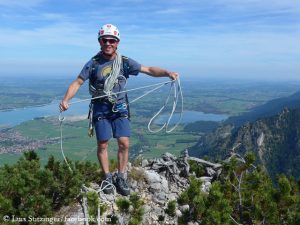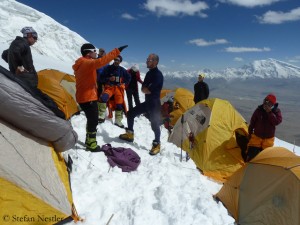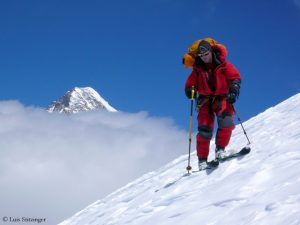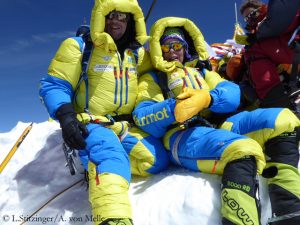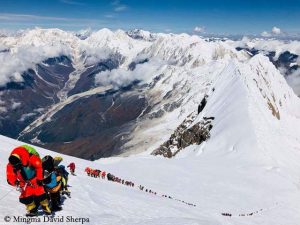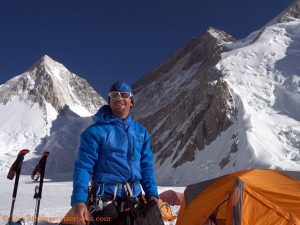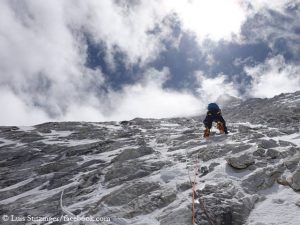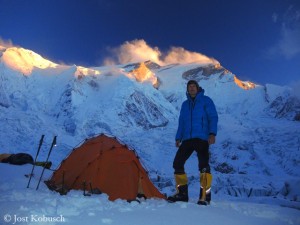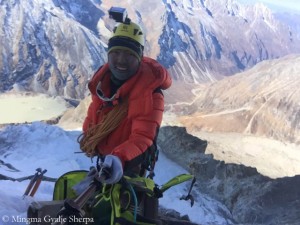Luis Stitzinger turns 50: “I’ll try Everest again”
Without him, I couldn’t call myself a first ascender. Luis Stitzinger was the expedition leader of the German operator “Amical alpin” in summer 2014, who led us to maximum success on the 7,129 meter high Kokodak Dome in western China: All 16 team members reached the summit – not least thanks to Luis’ experience and circumspection. Stitzinger already stood on eight eight-thousanders: Cho Oyu (in 2000), Gasherbrum II (2006), Nanga Parbat (2008), Dhaulagiri (2009), Broad Peak (2011), Shishapangma (2013), Manaslu (2017) and Gasherbrum I (2018). He scaled them all without bottled oxygen, six of them together with his wife Alix von Melle.
This Sunday, Luis will celebrate his 50th birthday, “under palm trees on a sandy beach,” he tells me laughing. With Alix, he treats himself to a three-week holiday in the Greek climbing paradise of Leonidio: “I gave it to myself for my birthday.” I spoke to him before he left to Greece.
Luis, half a century old, doesn’t even an experienced mountaineer get a bit dizzy?
The number five in front is a bit frightening at first sight. On the other hand, I had a year to get used to the idea. And if you think it back and forth, you also realize that this transition is only defined by man and that it is not razor-sharp. It is only a number. I still feel good. 50, that sounds a bit like close to retirement. But I actually don’t feel that way at all.
If you now compare yourself with Luis, who was 25 years old, do you still recognize yourself?
Yes, but of course I have also changed over time. I wouldn’t want to be 25 again because I feel much more confident now. I can enjoy things much more than I did then. If I could transport myself back in time, I would rather head for 36 or 38 years.
Why this age?
Because then you have already gained some experience in life. Also professionally I felt I had arrived. In my private and sporting life, that was an age at which I was well on my way and I was at one with myself. At mid-30s, you’re no longer a greenhorn, but you’re not really old either.
50 years is a mark to look both back and forward. Let’s first look back! Is there an achievement in your mountaineering career that you would like to highlight?
I like to think back to Nanga Parbat in 2008. We experienced there three times as much as others, because we were really on the mountain three times. First we reached the summit with the “DAV Summit Club” team via the Kinshofer route on the Diamir side of the mountain. Then I tried with my mountain companion Josef (Lunger) to traverse the Mazeno Ridge. We got to the Mazeno Col, but then we had to descend because we ran out of gas and food. And finally I succeeded a ski descent down the central Diamir flank.
You climbed your first eight-thousander, Cho Oyu, in 2000. From your point of view, how has mountaineering in the Himalayas and the Karakoram changed over the past 18 years?
On certain mountains there are much more climbers en route than back then, it has generally become more expensive and therefore more elitist. On some mountains only rich people are able to afford an expedition. The scene of the operators has changed too. Formerly there were only a few bigger companies, now there is a large number of operators. More and more local companies are taking over the market. They organize huge expeditions of several hundred people on the mountain – as for example on Manaslu in fall 2017.
In the meantime, Asians have also discovered high-altitude mountaineering for themselves. There are many people on the way, some of them inexperienced, who need comprehensive support. The change of style, away from the great eight-thousander expeditions of the early days towards individual mountaineering, which Messner, Habeler and others initiated, has reversed again.
That sounds as if you are concerned.
It doesn’t please me because it’s a very tippy thing in my eyes. It is safe as long as these inexperienced expedition members are massively looked after and the people in charge do the right things at the right time. But what if it happens too late or for some reason there is no support any more? Then it quickly becomes a dangerous all-or-nothing gamble. I expect a bigger accident to happen at some point. It will come inevitably.
Do you think such an accident would change anything?
I don’t think so. If you see, for example, how the expedition rules in Tibet have now been tightened, it’s actually completely into the wrong direction. Individual climbers are restricted, because the Chinese authorities see those who play their own game as a danger – even if they have the game under control and know what they are getting into. On the other hand, the authorities perceive as safe what the big operators are doing there: massive deployment of Climbing Sherpas and mountain guides in order to give the inexperienced clients as much staff as possible. For the authorities this is the path to the future. In case of an accident, there would probably be even more requirements for the operators, but individual mountaineering would hardly be strengthened again.
You are also working as a mountain guide for commercial groups. How do you resolve this conflict for yourself being part of the system on the one hand and realizing the negative aspects on the other hand?
Sometimes it is a tightrope walk. As German operators, we still have a slightly different tradition. The commercial expeditions in our country have developed out of group trips. The members are regarded more as self-reliant mountaineers and have to lend a hand. This is sometimes quite different with American or many Nepalese operators: There clients are kept on short rope and are of no account.
This year you scaled your eighth eight-thousander, Gasherbrum I in the Karakoram. How difficult or easy was it for you, or to put it another way: Did you feel that the ravages of time took their toll?
It was very exhausting, due to all the snow and because we were only a team of two. The other climbers had all descended in the storm of the previous day. Gianpaolo (Corona) and I were the last ones in the high camp and just tried it. It was 13 or 14 hours of stomping through deep snow. Although it was so exhausting, I really felt very good. Also in the days after I was not as burnt out as on some other mountains before.
Let’s look ahead! What goals do you still set in your mountaineering career?
At the age of 50 it’s not over yet! I still have some goals. I have not set myself an age limit. I just look at how I’m doing at the moment and then decide. Specifically, I’m planning to tackle Mount Everest again in spring 2019 from the north side (his first attempt there in 2015 failed because the mountain was closed after the earthquake in Nepal)– first as a mountain guide, as a work assignment. Maybe I can do something on the mountain myself afterwards with (Austrian) Rupert Hauer – a good friend of mine who leads another group on Everest.
Without bottled oxygen?
Yes, if possible without it.
Are the 14 eight-thousanders still a topic for you?
I have scaled eight of them so far, there are still six missing, that’s quite a lot. Usually, I try one mountain per year, and it doesn’t work every time. So six outstanding eight-thousanders means several years. I don’t know if I’m running out of time. I’m interested, but there are other things that might appeal to me even more, e.g. to climb a challenging route on an eight-thousander.
P.S.: Alix von Melle will not accompany Luis to Everest next spring, she is indispensable in her job.



